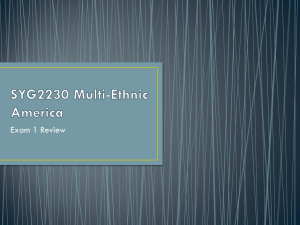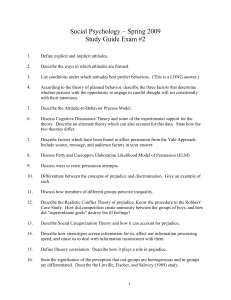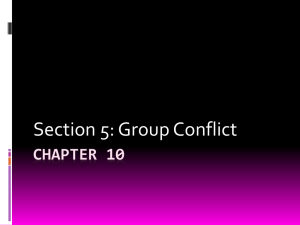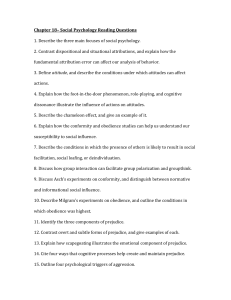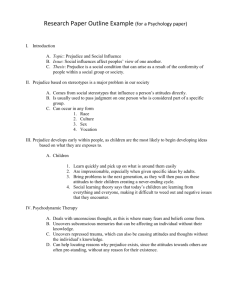Explanation of Prejudice
advertisement
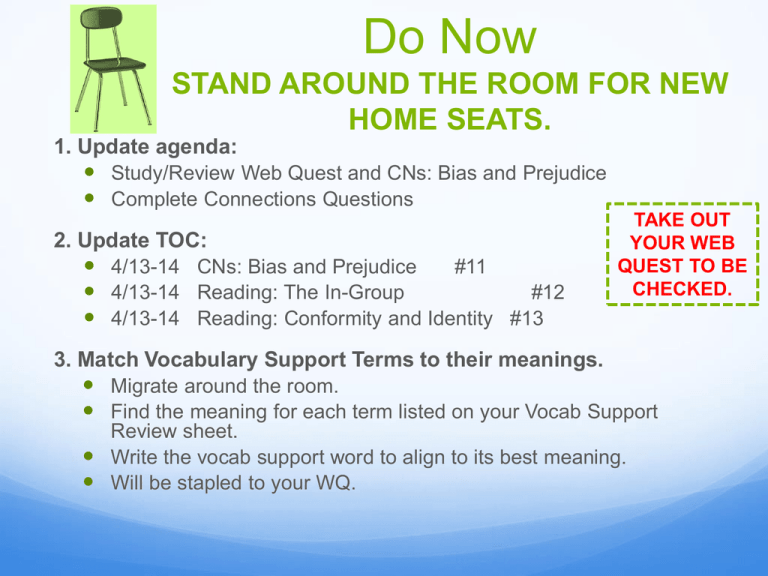
Do Now STAND AROUND THE ROOM FOR NEW HOME SEATS. 1. Update agenda: Study/Review Web Quest and CNs: Bias and Prejudice Complete Connections Questions 2. Update TOC: 4/13-14 CNs: Bias and Prejudice #11 4/13-14 Reading: The In-Group #12 4/13-14 Reading: Conformity and Identity #13 TAKE OUT YOUR WEB QUEST TO BE CHECKED. 3. Match Vocabulary Support Terms to their meanings. Migrate around the room. Find the meaning for each term listed on your Vocab Support Review sheet. Write the vocab support word to align to its best meaning. Will be stapled to your WQ. Vocab Support Check Think about this image. Which fruit stands out? Could it blend in? Can the single fruit change to look like and to be like the rest of the fruit? Should it in any case, need to blend in or need to change? Guided CNs: Groups and Prejudice Objective: Explain the link between the formation of groups to the development of prejudice. Recall what BIAS is… a tendency or slanted direction to believe that some people, ideas, etc., are better than others a feeling of like or dislike for someone or something especially when it is not reasonable or logical In-group Bias In-group bias is part of developing positive self-concept. Defines who we are in a positive way…answers, “Who am I?” Ex: “Which are better, the children in your school or the children at [another school nearby]?” Ex: Whites and Blacks report relations are generally good in their own neighborhood, but good relations for the country as a whole are less often reported. Prejudice & Discrimination • An attitude toward a person or social group/identity. • Often based on a stereotype. • Ex: Lesbian relationships are inappropriate. • A behavior or action toward a person Usuallynegative negative Usually and • Ex: Banning a lesbian couple from going to prom together. Explanations of Prejudice: 1) Authoritarian Personality People with this personality tend to view the world in a manner of hierarchy and may hope to see their group dominate above others. More submissive to higher authority Think less of lower authority level individuals Ex. Principal and Janitor Categories are highly rigid and not easily changed Preference for convention and a fear of new ideas Explanation of Prejudice: 2) Group Competition Realistic Conflict Theory: prejudice arises when groups compete for scarce resources Example of resources: land, jobs, mates Realistic Conflict Theory When have experienced, observed or learned about group competition? Research: Robbers Cave Two groups of boys are bussed into Robbers Cave State Park They camp and bond within their own groups The groups are then set up to compete against each other They bad mouth each other, burn their camp flags, ransack and Example: Waves of immigrants In the late 1800s and early to mid 1900s-over 400,000 Japanese steal They report highly positive attitudes about their own group and highly negative attitudes about the other group immigrants came to the U.S. They were skilled agricultural workers. Not always welcomed in California. (Competition) Mid 1900s worsened and camps were established (Fear) Solution: Superordinate Goals Desired goal that can only be achieved by cooperating with another group Social Identity How we fit in w/ society. Social Identity: personal identity, which includes abilities and attitudes, combined with our roles in society to create a sense of who we are Examples of roles: Hopeful Student; Caring Teacher; Affectionate son or daughter; Flute Player; Soccer Player; ADD YOUR OWN Explanation of Prejudice: 3) Social Identity Theory We Categorize: It’s useful to put people, and ourselves, into categories. The labels we use say more about the person. Examples: Catholic, Muslim; Guys, Girls; Mexican, Filipino We Identify: We connect ourselves with certain in-groups and build self esteem and pride based on our groups Ex.: Identify a group you’re proud to be a part of. We Compare: When similarities and differences arise among groups, we are biased to favor our own groups compared to outgroups which leads to in-group bias We feel superior to others THINK about this riddle: A father and son have a car accident and are both badly hurt. They are both taken to separate hospitals. When the boy is taken in for an operation, the surgeon (doctor) says 'I can not do the surgery because this is my son'. How is this possible? Hand up: 1=I KNOW THE SOLUTION 2=I THINK I KNOW THE SOLUTION 3=HOW CAN THIS BE!? Explanation of Prejudice: 4) Stereotypes Generalized assumptions that may lead to prejudice based on previous experience or observations. Can be positive or negative Old people are kind and sweet Old people are grumpy and hate life Women are nurturing and caring Women are terrible at mechanics Guide people in using little thought processes to make categories that help to organize experiences and situations #likeagirl Selective Exposure Hypothesis People prefer information that supports their preexisting opinions. We select resources that confirm our own ideas and avoid or downplay information that challenges or argues against our ideas. Helps to prevent cognitive dissonance. We need to work and being open-minded and at considering multiple points of view, which goes against our nature as humans. Reducing Negative Prejudice Developing a sense of empathy Put yourself in someone else’s place and gain a better understanding of that person Address and Restructure Social Norms Advocate for laws require and promote fair and equal treatment Rally for public support and raise awareness for anti-prejudice that exists Make People Aware Beliefs are inconsistent at times and need to be realigned Break barriers between social groups and get to know each other Look Over Your CNs Recall the Objective: Explain the link between the formation of groups to the development of prejudice. Place a star next to each concept that connects groups to attitudes, bias, or prejudice. Finalize CNs Highlight Key Terms Create HLQ to help you review. Develop a thorough summary statement that captures each main concept. Real Situations with Identity and Groups The “In” Group Conformity and Identity Meet Eve Shalen Meet Brandon Carson Read her story Read his story Follow directions Follow directions Needs to be complete before class on Wednesday.

